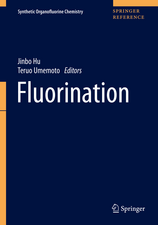The Role of Microstructure in Topical Drug Product Development: AAPS Advances in the Pharmaceutical Sciences Series, cartea 36
Editat de Nigel Langley, Bozena Michniak-Kohn, David W. Osborneen Limba Engleză Hardback – 24 aug 2019
Pharmaceutical development scientists that formulate topical products (creams, lotions, gels suspensions, foams, etc) and all the allied raw material suppliers, packaging suppliers, contract laboratories including CROs, CMOs and regulators need access to this book. Overall, the topic of semisolid microstructure is of equal importance to the generic pharmaceutical companies (filing Abbreviated New Drug Applications or ANDAs) and pharmaceutical companies filing New Drug Applications (NDAs). In addition to products applied to the skin, hair, and nails, The Role of Microstructure in Topical Drug Product Development’ crosses over and is essential reading to developers of oral suspensions, ophthalmic ointments and gels, otic suspension, vaginal semisolids and retention enemas.
| Toate formatele și edițiile | Preț | Express |
|---|---|---|
| Paperback (1) | 987.83 lei 6-8 săpt. | |
| Springer International Publishing – 25 aug 2020 | 987.83 lei 6-8 săpt. | |
| Hardback (1) | 993.81 lei 6-8 săpt. | |
| Springer International Publishing – 24 aug 2019 | 993.81 lei 6-8 săpt. |
Din seria AAPS Advances in the Pharmaceutical Sciences Series
- 5%
 Preț: 1054.33 lei
Preț: 1054.33 lei - 5%
 Preț: 1476.07 lei
Preț: 1476.07 lei - 18%
 Preț: 1124.62 lei
Preț: 1124.62 lei - 18%
 Preț: 951.17 lei
Preț: 951.17 lei - 18%
 Preț: 953.36 lei
Preț: 953.36 lei - 18%
 Preț: 1391.57 lei
Preț: 1391.57 lei - 18%
 Preț: 1551.69 lei
Preț: 1551.69 lei - 18%
 Preț: 1224.58 lei
Preț: 1224.58 lei - 18%
 Preț: 945.55 lei
Preț: 945.55 lei - 15%
 Preț: 640.22 lei
Preț: 640.22 lei - 5%
 Preț: 1618.19 lei
Preț: 1618.19 lei - 24%
 Preț: 791.47 lei
Preț: 791.47 lei - 5%
 Preț: 1416.17 lei
Preț: 1416.17 lei - 15%
 Preț: 647.05 lei
Preț: 647.05 lei - 18%
 Preț: 940.38 lei
Preț: 940.38 lei - 18%
 Preț: 1549.21 lei
Preț: 1549.21 lei - 18%
 Preț: 1561.75 lei
Preț: 1561.75 lei - 18%
 Preț: 1385.14 lei
Preț: 1385.14 lei - 18%
 Preț: 995.22 lei
Preț: 995.22 lei - 18%
 Preț: 1378.72 lei
Preț: 1378.72 lei - 18%
 Preț: 1005.39 lei
Preț: 1005.39 lei - 18%
 Preț: 1226.31 lei
Preț: 1226.31 lei - 18%
 Preț: 995.54 lei
Preț: 995.54 lei - 18%
 Preț: 945.69 lei
Preț: 945.69 lei - 18%
 Preț: 1126.63 lei
Preț: 1126.63 lei - 18%
 Preț: 1398.79 lei
Preț: 1398.79 lei - 18%
 Preț: 987.83 lei
Preț: 987.83 lei - 18%
 Preț: 1011.83 lei
Preț: 1011.83 lei - 18%
 Preț: 1823.68 lei
Preț: 1823.68 lei - 15%
 Preț: 655.96 lei
Preț: 655.96 lei
Preț: 993.81 lei
Preț vechi: 1211.96 lei
-18% Nou
Puncte Express: 1491
Preț estimativ în valută:
190.32€ • 194.21$ • 160.13£
190.32€ • 194.21$ • 160.13£
Carte tipărită la comandă
Livrare economică 25 februarie-11 martie
Preluare comenzi: 021 569.72.76
Specificații
ISBN-13: 9783030173548
ISBN-10: 3030173542
Pagini: 390
Ilustrații: XIV, 199 p. 102 illus., 57 illus. in color.
Dimensiuni: 155 x 235 x 16 mm
Greutate: 0.48 kg
Ediția:1st ed. 2019
Editura: Springer International Publishing
Colecția Springer
Seria AAPS Advances in the Pharmaceutical Sciences Series
Locul publicării:Cham, Switzerland
ISBN-10: 3030173542
Pagini: 390
Ilustrații: XIV, 199 p. 102 illus., 57 illus. in color.
Dimensiuni: 155 x 235 x 16 mm
Greutate: 0.48 kg
Ediția:1st ed. 2019
Editura: Springer International Publishing
Colecția Springer
Seria AAPS Advances in the Pharmaceutical Sciences Series
Locul publicării:Cham, Switzerland
Cuprins
Part I - Critical Quality Attributes: 1. Rheological Characterization in the Development of Topical Drug Products.- 2. In Vitro Release & Permeation Tests as Critical Quality Attributes in Topical Product Development.- 3. Determination of Particle Size and Microstructure in Topical Pharmaceuticals.- Part II - Role of API and Excipients: 4. Quality Assessment of API in Semisolid Topical Drug Products.- 5. The Role of Excipients in the Microstructure of Topical Semi-solid Drug Products.
Notă biografică
Nigel Langley, Director Technical Service and Scientific Affairs – BASF Pharma Solutions, provides technical support to the pharmaceutical industry and helps solve drug development challenges with BASF's platform solutions. Prior to joining BASF, Dr. Langley worked for Croda Inc. as Technical Director Health Care, responsible for product and application development for both dietary supplements and Pharmaceutical excipients. He has also worked in Japan and England with Croda. He gained his Chemistry (Hons) degree and PhD (Liquid Crystals) from the University of Hull, (UK) and an MBA from Leeds University (UK). Nigel has been a member of the Executive Committee at IPEC Americas since 2010 and is currently VC membership. He is also helping to lead the Novel excipient initiative in collaboration with the IQ Pharma Consortium. Nigel has 30 years’ experience within the Pharmaceutical excipient industry.
Dr. Bozena B. Michniak-Kohn is a tenured Professor of Pharmaceutics at the Ernest Mario School of Pharmacy, and Founder /Director of the Center for Dermal Research CDR at Rutgers, The State University of New Jersey. Her main focus is topical, transdermal and buccal drug delivery. Dr. Michniak-Kohn has nearly 40 years’ experience in design & optimization of topically applied formulations and transdermal patches. Dr. Michniak-Kohn received her B. Sc. (Honors) in Pharmacy and Ph.D. in Pharmacology from the U.K. Dr. Michniak-Kohn has directed over 50 Ph.D. and Masters students and the work resulted in over 135 peer-reviewed manuscripts, over 425 abstracts, 2 books, and 35 book chapters. She is a member of 10 journal editorial boards, several scientific advisory boards, member of Board of Trustees at TRI, Princeton and is a reviewer for about 44 pharmaceutical and drug delivery journals. For this work, she was awarded Fellow status of the American Association of Pharmaceutical Scientists (AAPS) in 2008.
David Osborne received his BS in Chemistry from Missouri State University and a PhD in Physical Chemistry in 1985 from Missouri University of Science and Technology under the direction of Professor Stig E. Friberg. Dr. Osborne honed his pharmaceutical product development skills while employed at The Upjohn Company (now Pfizer) and Calgon Vestal Labs (a Merck subsidiary). In 1993 he became Vice President of R&D for ViroTex Corporation which was acquired by Atrix Laboratories in 1998. David left his position as VP of the Dermatology Division at Atrix in 2003 to join Dow Pharmaceutical Sciences as VP Product Development until 2008. Dr. Osborne led Product Development at TOLMAR, Inc. from 2008 until retiring as Chief Scientific Officer in May 2016. David Osborne has over 100 issued patents and 50 publications primarily in the areas of surfactants, formulations and skin delivery. He edited the book Topical Drug Delivery Formulations (Marcel Dekker, 1990) and is the inventor and developer of Aczone (5% dapsone topical gel). Under his leadership, more than 30 NDA, ANDA, and OTC products have been launched which had one year combined sales in 2015 of over $1.2 billion. He was the 1992 chairman of the ACS Division of Colloid and Surface Chemistry, founding North American Editor of the journal Colloids and Surfaces: Biointerfaces and the 2001 MSU Outstanding Young Alumni.
Dr. Bozena B. Michniak-Kohn is a tenured Professor of Pharmaceutics at the Ernest Mario School of Pharmacy, and Founder /Director of the Center for Dermal Research CDR at Rutgers, The State University of New Jersey. Her main focus is topical, transdermal and buccal drug delivery. Dr. Michniak-Kohn has nearly 40 years’ experience in design & optimization of topically applied formulations and transdermal patches. Dr. Michniak-Kohn received her B. Sc. (Honors) in Pharmacy and Ph.D. in Pharmacology from the U.K. Dr. Michniak-Kohn has directed over 50 Ph.D. and Masters students and the work resulted in over 135 peer-reviewed manuscripts, over 425 abstracts, 2 books, and 35 book chapters. She is a member of 10 journal editorial boards, several scientific advisory boards, member of Board of Trustees at TRI, Princeton and is a reviewer for about 44 pharmaceutical and drug delivery journals. For this work, she was awarded Fellow status of the American Association of Pharmaceutical Scientists (AAPS) in 2008.
David Osborne received his BS in Chemistry from Missouri State University and a PhD in Physical Chemistry in 1985 from Missouri University of Science and Technology under the direction of Professor Stig E. Friberg. Dr. Osborne honed his pharmaceutical product development skills while employed at The Upjohn Company (now Pfizer) and Calgon Vestal Labs (a Merck subsidiary). In 1993 he became Vice President of R&D for ViroTex Corporation which was acquired by Atrix Laboratories in 1998. David left his position as VP of the Dermatology Division at Atrix in 2003 to join Dow Pharmaceutical Sciences as VP Product Development until 2008. Dr. Osborne led Product Development at TOLMAR, Inc. from 2008 until retiring as Chief Scientific Officer in May 2016. David Osborne has over 100 issued patents and 50 publications primarily in the areas of surfactants, formulations and skin delivery. He edited the book Topical Drug Delivery Formulations (Marcel Dekker, 1990) and is the inventor and developer of Aczone (5% dapsone topical gel). Under his leadership, more than 30 NDA, ANDA, and OTC products have been launched which had one year combined sales in 2015 of over $1.2 billion. He was the 1992 chairman of the ACS Division of Colloid and Surface Chemistry, founding North American Editor of the journal Colloids and Surfaces: Biointerfaces and the 2001 MSU Outstanding Young Alumni.
Textul de pe ultima copertă
Following the Semi-solid Microstructure Workshop sponsored by BASF and hosted by the Rutgers Center for Dermal Research, a pharmaceutical product development working group was formed. The group, known as the Q3 Working Group, selected the following five areas of focus: Particle/Globule Size and Distribution, Viscosity/Rheology/Spreadability, In Vitro Testing, State of API, State of Excipients. A committee was appointed for each of these five areas. The committees were tasked to review the literature, identify best practices, list experimental details required for an independent lab to duplicate the test, and propose scientific studies that may meaningfully advance this specific area of focus. Each committee has a chair (or co-chairs) that are the lead author(s) of the chapter. The Q3 Working Group members serve as the critical reviewers of each chapter, making suggestions thatimprove the quality of the document and that make each of the five chapters uniform in scope and content.
Pharmaceutical development scientists that formulate topical products (creams, lotions, gels suspensions, foams, etc) and all the allied raw material suppliers, packaging suppliers, contract laboratories including CROs, CMOs and regulators need access to this book. Overall, the topic of semisolid microstructure is of equal importance to the generic pharmaceutical companies (filing Abbreviated New Drug Applications or ANDAs) and pharmaceutical companies filing New Drug Applications (NDAs). In addition to products applied to the skin, hair, and nails, The Role of Microstructure in Topical Drug Product Development crosses over and is essential reading to developers of oral suspensions, ophthalmic ointments and gels, otic suspension, vaginal semisolids and retention enemas.
Caracteristici
Based on findings from a pharmaceutical product development group arising out of the 2016 Semi-solid Microstructure Workshop sponsored by BASF and hosted by the Rutgers Center for Dermal Research Presents five crucial areas in semi-solid microstructure topical drug product development Reviews the literature Identifies best practices Lists experimental details necessary to duplicate the tests Identifies scientific studies that advance the subject areas



























